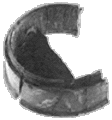
Commerce & Trade | Working the Ship | Weaponry
 Standing rigging consists of a series of stays and shrouds that are
designed to hold masts up-right. Stays are large gauge ropes that run
forward of each mast, while shrouds are networks of ropes, arranged
vertically, that secure the masts on either side.
Standing rigging consists of a series of stays and shrouds that are
designed to hold masts up-right. Stays are large gauge ropes that run
forward of each mast, while shrouds are networks of ropes, arranged
vertically, that secure the masts on either side.
The upper shrouds are connected by deadeyes and lanyards to futtock plates.
The futtock plates then attach these shrouds to the lower sets by wooden
platforms on the mast. The lower sets are also linked by deadeyes and
lanyards and then attached to huge chains lodged into the ship's hull.

Futtock plate attached to a deadeye found on the Machault.
Running Blocks
|
Running blocks were used to move heavy objects, work sails, and to maneuver
cannons. Hundreds of running blocks, set up in pulley systems, were needed
to operate the Machault. Most shells have deeply scored troughs at their
bases and up their sides to accommodate the rope rings that held the blocks
in position.
|

|
|
The mast truck, normally with two sheaves, wraps around an upper mast. Its sheaves were threaded with signal halyards to raise and lower signaling pennants for ship-to-ship or ship-to-shore communication.
 A badly burned mast truck found at the excavation site. |
 Diagram of a mast truck. |
| The cheek block was linked to the top and bottom of an upper mast and used to work one of the auxiliary stay sails. |
|
Navigation
|
"Navigation was not a precise science in 1760. The navigator determined
latitude by measuring the angle between the horizon and a particular point
in heaven. This reading is then converted into degrees of latitude."
24 From such bearings, the navigator could calculate the ship's
position and the distance it travelled. Keep in mind, he was only as
accurate as his equipment and as the skies permitted. Navigational instruments recovered from the Machault included part of a back staff (for taking an indirect reading of the angle between the horizon and the sun), a pair of draughting dividers, what may be a compass box, a slate pencil, and a slate table fragment."
| |
 Compass box, missing it's srew-on lid. |
 Pair of draughtings dividers, their steel pointers rusted away. |
Sailmaker's Tools & Pumps
|
"Sailmakers, caulkers, and carpenters were responsible for inspecting and
restoring the sails, rigging, and repairing the ship's hull and
other wooden components, including its wooden provision casts. A sailmaker
might have used awl-like tools to pierce holes around a sail so he could
stitch a reinforcing cord to the sail's edges."25
|
 Wooden awl handles. |
|
The sailmaker wore a flat brass disc, attached by its three ears to a strip
of leather around his hand, as a thimble for pushing large needles through
heavy fabric."
|
 Sailmaker's brass disc. |
|
The main pumps on a wooden frigate were located beside the mainmast,
extending the full height of the hull, and giving onto a deck where the
water could escape into the sea. Wooden ships could not stay afloat
without being pumped out several times a day. The Machault originally had
four pumps around its mainmast, but only three were recovered. The pumps
operated on a suction system, raising water out of the hold in two stages.
These pumps were very common at this period in time.
|
|
